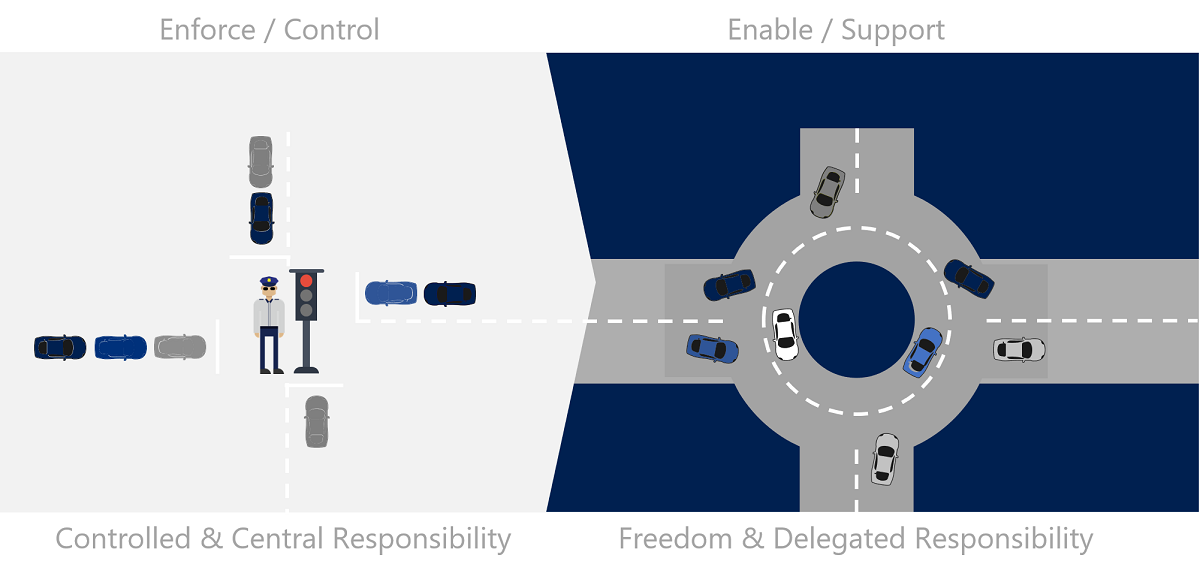Customer narrative
In earlier Microsoft Learn modules for the Cloud Adoption Framework, we shared the narrative of Tailwind Traders. This module is the first step toward Tailwind's cloud adoption journey. The Tailwind team is evaluating its strategic direction and ensuring stakeholder buy-in before committing to a cloud effort.
The following excerpts from the customer narrative outline strategic objectives for Tailwind Traders.
Innovation objectives
Like most businesses, Tailwind is attempting to balance two competing business drivers: digital transformation and risk mitigation.
The Tailwind Traders retail innovation team uses technology to continually redefine the company's position as a leader in modern commerce. Those technology solutions are the primary hub for interactions with Tailwind customers. The solutions affect 60 percent of global revenue and produce 30 percent of annual gross sales. A few examples of those innovations include:
- Boundless commerce: Originally a simple e-commerce solution, this custom-built platform now provides online and offline experiences for customers. Customers can make purchases from the platform. The mobile app gathers information from the customers' viewing history to customize the retail experience with in-store ads, shopping lists, and other interactions.
- Analytics, AI, and robotics innovation: Tailwind is experimenting with drone delivery, autonomous warehousing, and other AI-led approaches to reduce costs, scale through automation, and improve customer experiences. These experiments are built on big data, analytics, and AI solutions.
Migration objectives
In addition to new innovations, Tailwind Traders' central IT team supports the back office and its store technologies. The company's central IT team supports 3,500 employees. Fewer than 100 Tailwind employees are dedicated to IT. The IT team represents most of the technical staff, with roughly 80 employees focused on supporting the following types of technologies:
- Smart storefronts: Environmental controls, doors, lighting, interactive shelves, in-store displays and advertisements, and more than 500 point-of-sale systems.
- Corporate headquarters: More than 900 employees are hosted in corporate headquarters, with technology systems that offer best-in-class solutions. These solutions support processes like real estate, logistics, supply chain, pricing, human resources, employee schedules and tracking, and payroll.
- User workstations: Mostly desktop-based, with a growing percentage of employees opting for mobile, bring your own device (BYOD), in-store kiosks, and virtual desktop solutions.
- Central operations: Ongoing technical operations for all IT and retail innovation assets.
The company currently has three datacenters. The leases for two of its datacenters are due to end in 18 months and 24 months. The IT manager and finance director have been talking, and they don't want to renew the leases. Instead, they're considering a project to upgrade, consolidate, and use the cloud as a replacement for the two expiring datacenters. The CIO sees this project as an opportunity to rethink IT operations for the company.
Strategic priorities
Tailwind Traders has a new CIO because of a recent retirement. The new CIO is focused on improving technical operations in several areas to fuel greater innovation throughout the company, but while limiting disruptions to core business operations. The cloud plays an important role in this transition.

A cornerstone of the new strategy is a shift in the operating model. Tailwind is moving from a centralized command-and-control operating model to a model that focuses on delegated responsibilities led by a cloud center of excellence team. This transition is expected to take several years. The CIO is looking for small, incremental steps to transition the company in each of the coming projects.
The CIO also uses the Cloud Adoption Strategy Evaluator to assess the company’s cloud adoption plan and get recommendations on building or advancing the cloud business case. The Cloud Adoption Strategy Evaluator is based on the Cloud Adoption Framework. It helps organizations assess their approach to cloud adoption. This assessment makes recommendations based on the principles of cloud economics that help an organization create a robust business case and enable successful cloud adoption.
Transitioning to this new operating model is expected to reduce vendor complexity and Tailwind's overall cost of operations. The CIO plans to use the redistributed savings to further accelerate technical and operational capabilities, increasing the IT team's position as an innovation leader across the business.